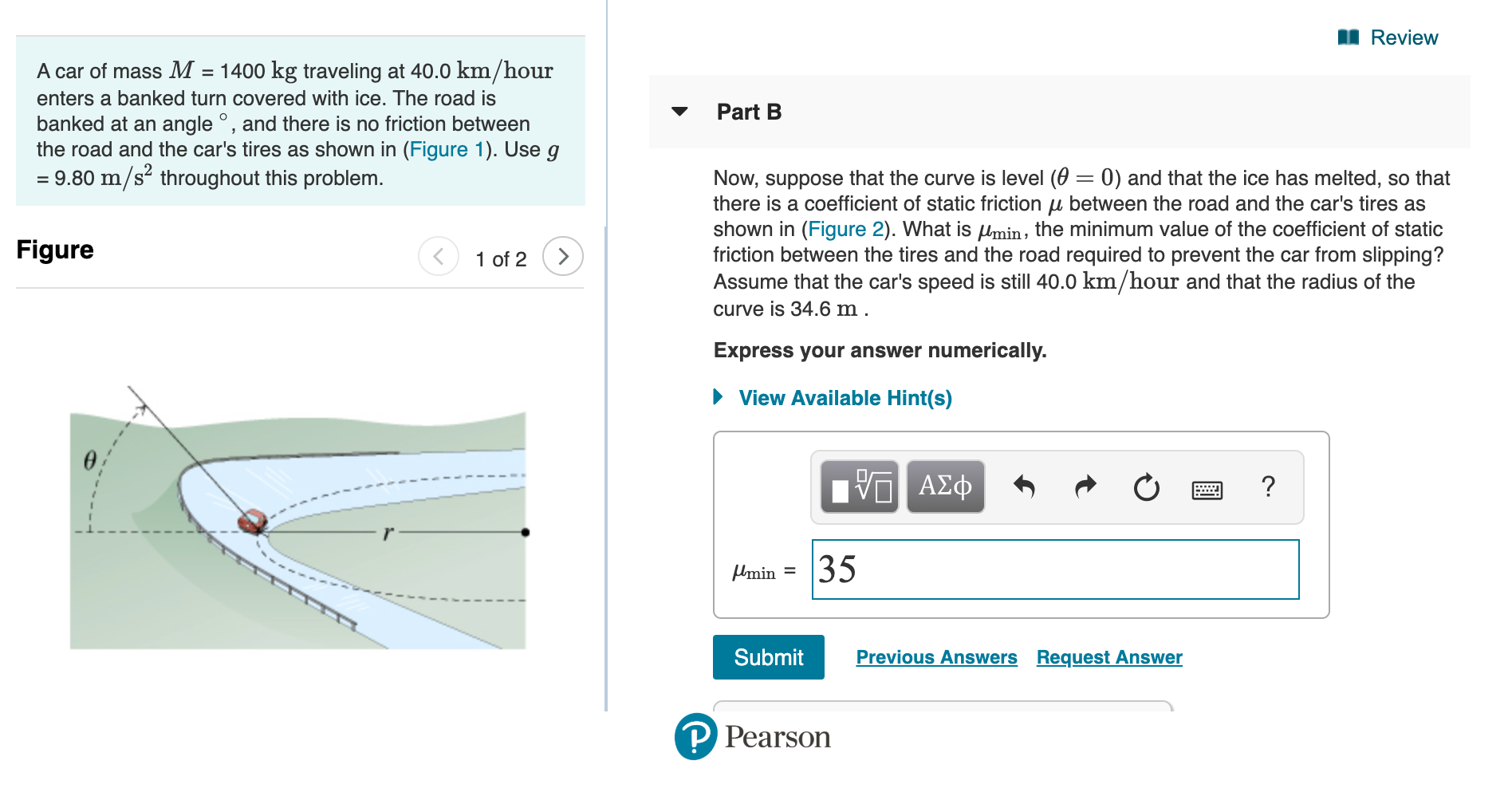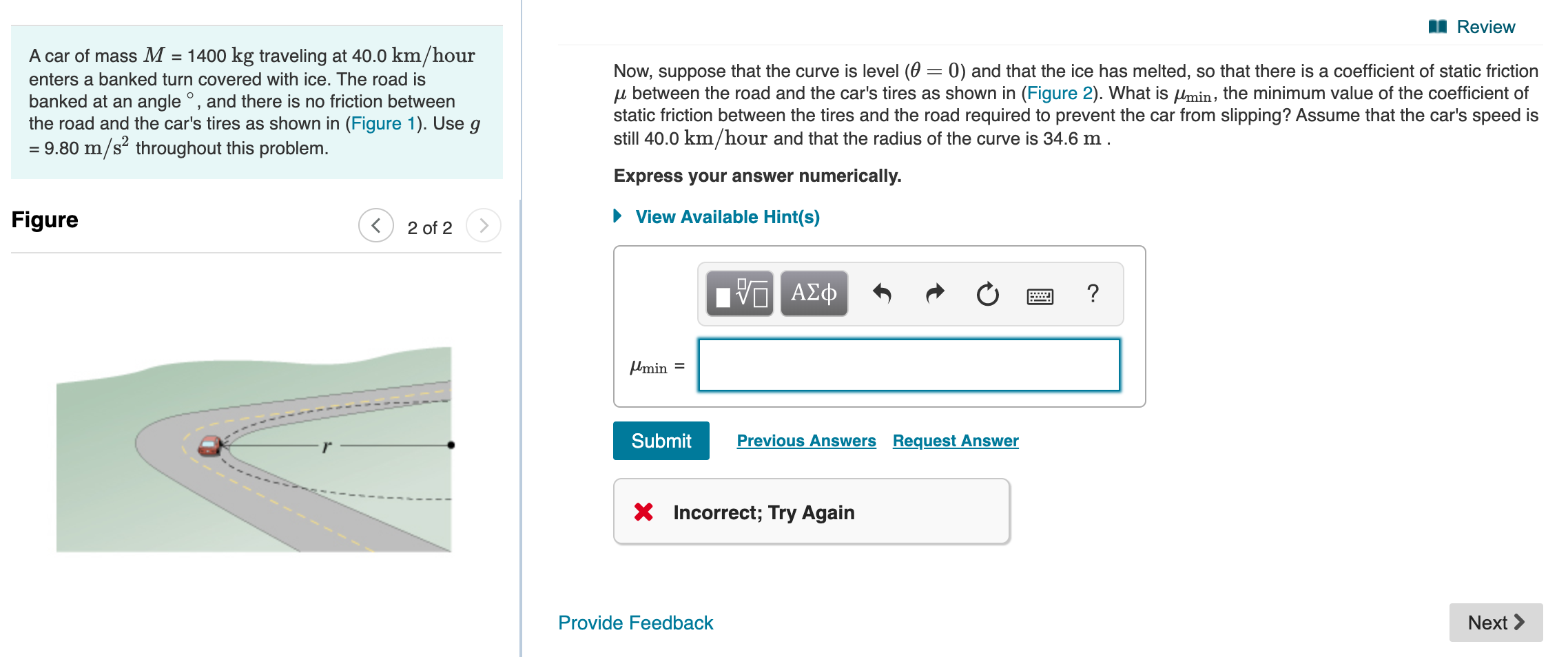I Review A car of mass M = 1400 kg traveling at 40.0 km/hour %D enters a banked turn covered with ice. The road is Part B banked at an angle °, and there is no friction between the road and the car's tires as shown in (Figure 1). Use g = 9.80 m/s? throughout this problem. Now, suppose that the curve is level (0 = 0) and that the ice has melted, so that there is a coefficient of static friction u between the road and the car's tires as shown in (Figure 2). What is Umin, the minimum value of the coefficient of static friction between the tires and the road required to prevent the car from slipping? Assume that the car's speed is still 40.0 km/hour and that the radius of the Figure 1 of 2 curve is 34.6 m . Express your answer numerically. • View Available Hint(s) Πνα ΑΣφ 35 lmin %3D Submit Previous Answers Request Answer P Pearson I Review A car of mass M = 1400 kg traveling at 40.0 km/hour Now, suppose that the curve is level (0 = 0) and that the ice has melted, so that there is a coefficient of static friction u between the road and the car's tires as shown in (Figure 2). What is umin, the minimum value of the coefficient of static friction between the tires and the road required to prevent the car from slipping? Assume that the car's speed is still 40.0 km/hour and that the radius of the curve is 34.6 m. enters a banked turn covered with ice. The road is banked at an angle °, and there is no friction between the road and the car's tires as shown in (Figure 1). Use g = 9.80 m/s throughout this problem. Express your answer numerically. Figure View Available Hint(s) 2 of 2 V ΑΣφ Umin = Submit Previous Answers Request Answer X Incorrect; Try Again Provide Feedback Next >
I Review A car of mass M = 1400 kg traveling at 40.0 km/hour %D enters a banked turn covered with ice. The road is Part B banked at an angle °, and there is no friction between the road and the car's tires as shown in (Figure 1). Use g = 9.80 m/s? throughout this problem. Now, suppose that the curve is level (0 = 0) and that the ice has melted, so that there is a coefficient of static friction u between the road and the car's tires as shown in (Figure 2). What is Umin, the minimum value of the coefficient of static friction between the tires and the road required to prevent the car from slipping? Assume that the car's speed is still 40.0 km/hour and that the radius of the Figure 1 of 2 curve is 34.6 m . Express your answer numerically. • View Available Hint(s) Πνα ΑΣφ 35 lmin %3D Submit Previous Answers Request Answer P Pearson I Review A car of mass M = 1400 kg traveling at 40.0 km/hour Now, suppose that the curve is level (0 = 0) and that the ice has melted, so that there is a coefficient of static friction u between the road and the car's tires as shown in (Figure 2). What is umin, the minimum value of the coefficient of static friction between the tires and the road required to prevent the car from slipping? Assume that the car's speed is still 40.0 km/hour and that the radius of the curve is 34.6 m. enters a banked turn covered with ice. The road is banked at an angle °, and there is no friction between the road and the car's tires as shown in (Figure 1). Use g = 9.80 m/s throughout this problem. Express your answer numerically. Figure View Available Hint(s) 2 of 2 V ΑΣφ Umin = Submit Previous Answers Request Answer X Incorrect; Try Again Provide Feedback Next >
Principles of Physics: A Calculus-Based Text
5th Edition
ISBN:9781133104261
Author:Raymond A. Serway, John W. Jewett
Publisher:Raymond A. Serway, John W. Jewett
Chapter5: More Applications Of Newton’s Laws
Section: Chapter Questions
Problem 19P: A crate of eggs is located in the middle of the flatbed of a pickup truck as the truck negotiates a...
Related questions
Question
A car of mass M = 1400 kg traveling at 40.0 km/hour enters a banked turn covered with ice. The road is banked at an angle, and there is no friction between the road and the car's tires as shown in (Figure 1). Use g = 9.80 m/s2 throughout this problem.
Now, suppose that the curve is level (θ=0) and that the ice has melted, so that there is a coefficient of static friction μ between the road and the car's tires as shown in (Figure 2). What is μmin, the minimum value of the coefficient of static friction between the tires and the road required to prevent the car from slipping? Assume that the car's speed is still 40.0 km/hour and that the radius of the curve is 34.6 mm .
Express your answer numerically.

Transcribed Image Text:I Review
A car of mass M = 1400 kg traveling at 40.0 km/hour
%D
enters a banked turn covered with ice. The road is
Part B
banked at an angle °, and there is no friction between
the road and the car's tires as shown in (Figure 1). Use g
= 9.80 m/s? throughout this problem.
Now, suppose that the curve is level (0 = 0) and that the ice has melted, so that
there is a coefficient of static friction u between the road and the car's tires as
shown in (Figure 2). What is Umin, the minimum value of the coefficient of static
friction between the tires and the road required to prevent the car from slipping?
Assume that the car's speed is still 40.0 km/hour and that the radius of the
Figure
1 of 2
curve is 34.6 m .
Express your answer numerically.
• View Available Hint(s)
Πνα ΑΣφ
35
lmin
%3D
Submit
Previous Answers Request Answer
P Pearson

Transcribed Image Text:I Review
A car of mass M
= 1400 kg traveling at 40.0 km/hour
Now, suppose that the curve is level (0 = 0) and that the ice has melted, so that there is a coefficient of static friction
u between the road and the car's tires as shown in (Figure 2). What is umin, the minimum value of the coefficient of
static friction between the tires and the road required to prevent the car from slipping? Assume that the car's speed is
still 40.0 km/hour and that the radius of the curve is 34.6 m.
enters a banked turn covered with ice. The road is
banked at an angle °, and there is no friction between
the road and the car's tires as shown in (Figure 1). Use g
= 9.80 m/s throughout this problem.
Express your answer numerically.
Figure
View Available Hint(s)
2 of 2
V ΑΣφ
Umin =
Submit
Previous Answers Request Answer
X Incorrect; Try Again
Provide Feedback
Next >
Expert Solution
This question has been solved!
Explore an expertly crafted, step-by-step solution for a thorough understanding of key concepts.
This is a popular solution!
Trending now
This is a popular solution!
Step by step
Solved in 3 steps with 4 images

Knowledge Booster
Learn more about
Need a deep-dive on the concept behind this application? Look no further. Learn more about this topic, physics and related others by exploring similar questions and additional content below.Recommended textbooks for you

Principles of Physics: A Calculus-Based Text
Physics
ISBN:
9781133104261
Author:
Raymond A. Serway, John W. Jewett
Publisher:
Cengage Learning

University Physics Volume 1
Physics
ISBN:
9781938168277
Author:
William Moebs, Samuel J. Ling, Jeff Sanny
Publisher:
OpenStax - Rice University

Principles of Physics: A Calculus-Based Text
Physics
ISBN:
9781133104261
Author:
Raymond A. Serway, John W. Jewett
Publisher:
Cengage Learning

University Physics Volume 1
Physics
ISBN:
9781938168277
Author:
William Moebs, Samuel J. Ling, Jeff Sanny
Publisher:
OpenStax - Rice University